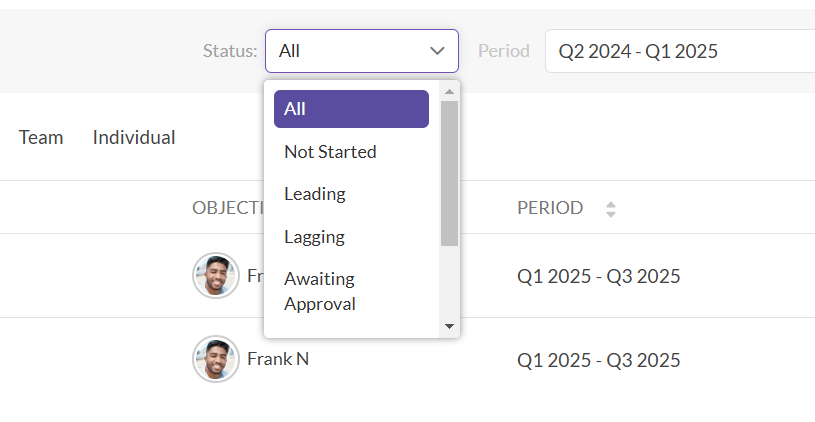Exploring Hierarchy Tree - List View
Modified on: Wed, 29 Jan, 2025 at 4:23 PM
Synergita OKR's hierarchy feature provides an insightful and structured way to manage organizational objectives. While the Tree View offers a visual map of objectives, the List View presents a more traditional, tabular representation. This article shows the functionalities of the List View and how to effectively use it.
Accessing the Hierarchy List View
- Navigate to OKR Hierarchy tab on the left-navigation pane.

- The tree view is the default view when the page is opened. The filter panel can be used to switch between tree view and list view.

Overview of the List View
 The List View in the OKR Hierarchy allows users to see all objectives in a structured list format. Both aligned and unaligned objectives can be viewed in the list view.
The List View in the OKR Hierarchy allows users to see all objectives in a structured list format. Both aligned and unaligned objectives can be viewed in the list view. - The list view is particularly useful for users who prefer a straightforward, linear approach to data representation.

- When an objective is expanded in the list view, the key results is displayed, along with the progress percentage for each key result.

Features of the List View
- Tabular Format: Objectives and their corresponding key results are displayed in rows and columns, providing a clear and concise overview.
- Sorting Options: Easily sort objectives based on different criteria such as status, owner, alignment, etc.

- Filtering Capabilities: Apply filters to view specific sets of objectives, like team-specific or individual-specific OKRs.
Updating Objectives in List View
- The progress of an objective can be updated from the List View by clicking on the key results in the expanded mode..
- In the aligned objectives tab, the parent objective can be viewed in the last column. Clicking on it opens the Details page of parent objective.
- In the unaligned objectives tab, they can be aligned to an existing objective from the last column. Clicking on the Align To button allows to align the objective.

Did you find it helpful?
Yes
No
Can you please tell us how we can improve this article?


 The List View in the OKR Hierarchy allows users to see all objectives in a structured list format. Both aligned and unaligned objectives can be viewed in the list view.
The List View in the OKR Hierarchy allows users to see all objectives in a structured list format. Both aligned and unaligned objectives can be viewed in the list view. 



